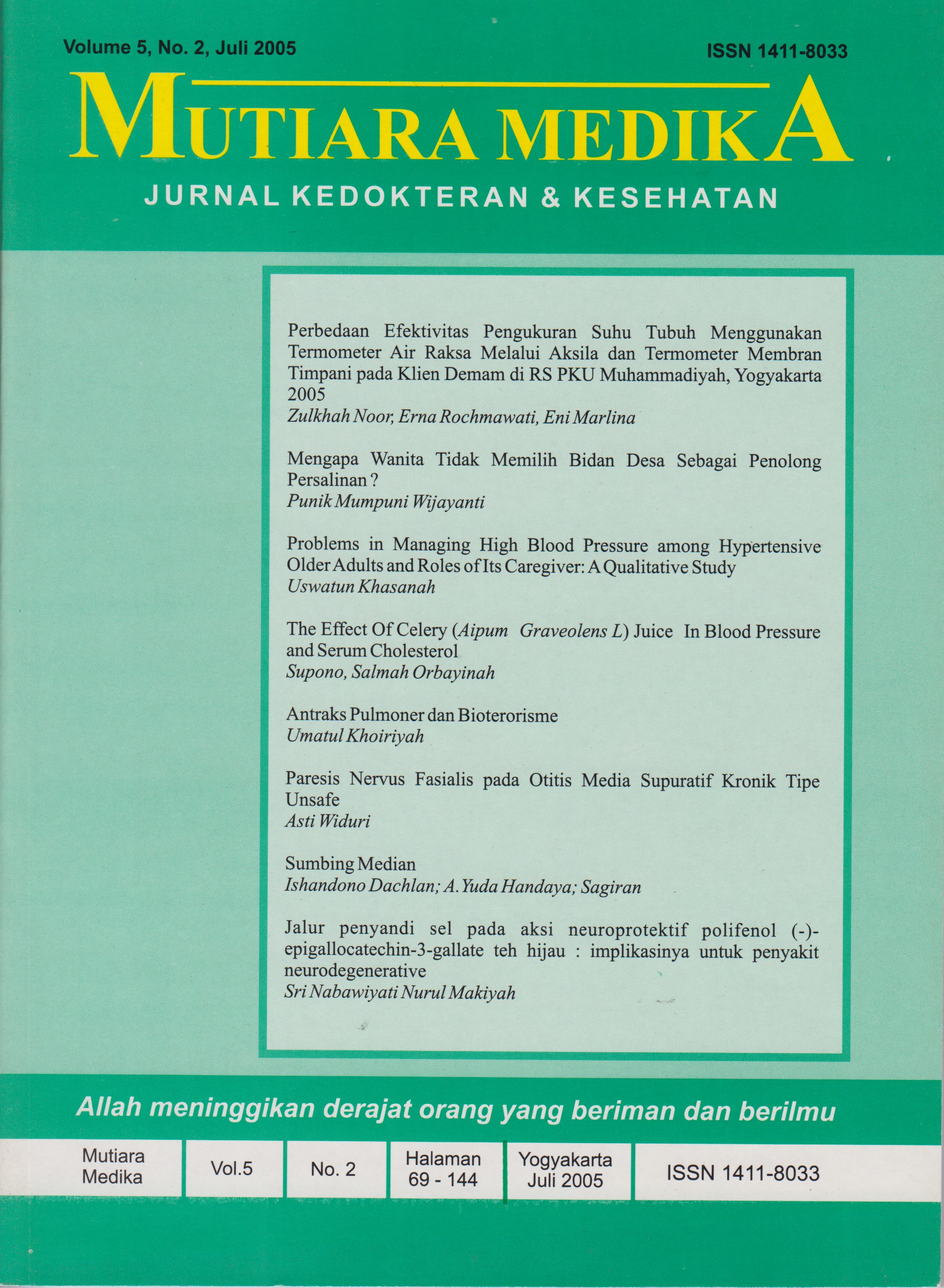Perbedaan Efektivitas Pengukuran Suhu Tubuh Menggunakan Termometer Air Raksa Melalui Aksila dan Termometer Membran Timpani pada Klien Demam di RS PKU Muhammadiyah, Yogyakarta 2005
DOI:
https://doi.org/10.18196/mmjkk.v5i2.1878Keywords:
Efektivitas, pengukuran suhu tubuh, termometer air raksa, termometer membran timpani, demam, effectiveness, body temperature measurement, mercury thermometer, timpani membrane thermomete, fever.Abstract
Body temperature is one of the indications of health status and it may be above normal. The average number of clients suffering from fever increases 35% each month. Knowing the body temperature is one of an effective ways to understand the vital symptoms before giving treatment. Thermometers which usually used to measure the body temperature are mercury and timpani membrane thermometers which each of them has its own characteristics. The aim of the study was to find the effectiveness of the two thermometers in measuring body temperature of clients suffering from fever in PKU Muhammadiyah Yogyakarta hospital.This is an observational study with cross sectional design. There were 30 respondents who suffer staying in recovery room. Their body temperatures were checked twice using mercury and timpani membrane thermometers in order to determine the result of measurement, effective time of the measurement and response toward safety level and clients comfort. The subject analysis used t- test and Me Nemar.
There were 27 respondents (90%) felt more secure when measured by using mercury thermometer. Me Nemar test shows that mercury thermometer measures the body temperature saver than timpani membrane thermometer. There were 21 respondents (70%) felt more comfortable when their body temperatures were measured by using timpani membrane thermometer. Me Nemar test shows that timpani membrane thermometer measures the body temperature more comfortably. The average difference of the body temperature measured by using mercury thermometer (38,1 ± 0,7) and the average difference of the body temperature measured by using timpani membrane thermometer (38,3 ± 0,7) was ± 0,2. The t-test result shows that measuring the body temperature using mercury thermometer and timpani membrane thermometer does no have any significant difference.
The time needed to measure the body temperature using mercury thermometer is 5 minutes while timpani membrane thermometer needs 2 seconds to indicate the body temperature. The clients felt more secure when their body temperature are measured using mercury thermometer. On the other hand, the clients felt more comfortable when their body temperatures are measured using timpani membrane thermometer. The result of the body temperature measured using mercury thermometer and timpani membrane thermometer does not have any significant differences.
Suhu tubuh adalah salah satu indikator status kesehatan, perubahannya dapat melebihi nilai normal (demam). Rata-rata tingkat jumlah yang klien dengan demam sekitar 35% setiap bulannya. Tindakan keperawatan yang dapat dilakukan untuk pengkajian tanda vital yang cepat dan tepat yaitu dengan pengukuran suhu tubuh. Termometer yang sering digunakan yaitu termometer air raksa dan termometer membran timpani yang keduanya memiliki karakteristik tersendiri. Tujuan penelitian ini untuk mengetahui perbedaan efektivitas pengukuran suhu tubuh menggunakan termometer air raksa dan termometer membran timpani pada klien demam di RS PKU Muhammadiyah Yogyakarta.
Jenis penelitian observasional dengan rancangan belah lintang. Sampel adalah klien demam yang dirawat di instalansi rawat inap sebanyak 30 responden. Subyek mendapatkan dua kali pengukuran dengan termometer air raksa dan termometer membran timpani untuk menentukan hasil pengukuran, waktu efektif pengukuran, dan respon terhadap tingkat keamanan dan kenyamanan. Analisa subyek menggunakan uji t-test dan McNemar.
Sebanyak 27 orang klien demam (90%) merasa aman bila diukur dengan termometer air raksa. Uji McNemar, termometer air raksa mengukur suhu tubuh lebih aman. Sebanyak 21 orang klien demam (70%) merasa nyaman bila diukur dengan termometer membran timpani. Uji McNemar, termometer membran timpani mengukur suhu tubuh lebih nyaman. Perbedaan rata-rata pengukuran suhu dengan termometer air raksa (38,1±0,7) dan termometer membran timpani (38,3±0,7) ± 0,2. Uji t-test,
hasil pengukuran suhu tubuh dengan termometer air raksa berbeda tidak bermakna dengan termometer membran timpani.
Waktu efektif pengukuran suhu tubuh dengan termometer air raksa adalah 5 menit, sedangkan termometer membran timpani adalah 2 detik. Klien demam merasa lebih aman diukur dengan termometer air raksa. Klien demam merasa lebih nyaman diukur dengan termometer membran timpani. Hasil pengukuran suhu tubuh termometer air raksa berbeda tidak bermakna dengan termometer membran timpani.
References
Guyton, (1997). Fisiologi Manusia dan Mekanisme Penyakit. EGC : Jakarta
Potter, P.A., & Perry, A.G, (1996). Fundamentals of Nursing : Concepts, Process & Practice. Edisi IH. Mosby Year Book
Carpenito, LJ (2001). Buku Saku Diagnosa Keperawatan. Edisi VII. EGC : Jakarta
Potter, P.A., & Perry, A.G, (1993). Fundamentals of Nursing : Concepts, Process & Practice. Edisi III. Mosby Year Book
NANDA, (2001). Nursing Diagnoses.Prentice Hall
Ganong, W.F., (1999). Fisiologi Kedokteran . Edisi XVII. EGC : Jakarta
Rab, X, (2000). Pengatasan Shock. EGC : Jakarta
Friedman, (1998). Keperawatan Keluarga. EGC : Jakarta
Smith, S.L., (2003). Reexamining Age, race, Site and Thermometer type as variables Affecting temperature Measurement in Adults : A Comparison Study.
Hodkinson, C., Harrison, R., Child, C. (1998). Tympanic Membrane Temperature as A Measure of Core temperature
Downloads
Issue
Section
License
Copyright
Authors retain copyright and grant Mutiara Medika: Jurnal Kedokteran dan Kesehatan (MMJKK) the right of first publication with the work simultaneously licensed under an Attribution 4.0 International (CC BY 4.0) that allows others to remix, adapt and build upon the work with an acknowledgment of the work's authorship and of the initial publication in Mutiara Medika: Jurnal Kedokteran dan Kesehatan (MMJKK).
Authors are permitted to copy and redistribute the journal's published version of the work (e.g., post it to an institutional repository or publish it in a book), with an acknowledgment of its initial publication in Mutiara Medika: Jurnal Kedokteran dan Kesehatan (MMJKK).
License
Articles published in the Mutiara Medika: Jurnal Kedokteran dan Kesehatan (MMJKK) are licensed under an Attribution 4.0 International (CC BY 4.0) license. You are free to:
- Share — copy and redistribute the material in any medium or format.
- Adapt — remix, transform, and build upon the material for any purpose, even commercially.
This license is acceptable for Free Cultural Works. The licensor cannot revoke these freedoms as long as you follow the license terms. Under the following terms:
Attribution — You must give appropriate credit, provide a link to the license, and indicate if changes were made. You may do so in any reasonable manner, but not in any way that suggests the licensor endorses you or your use.
- No additional restrictions — You may not apply legal terms or technological measures that legally restrict others from doing anything the license permits.






